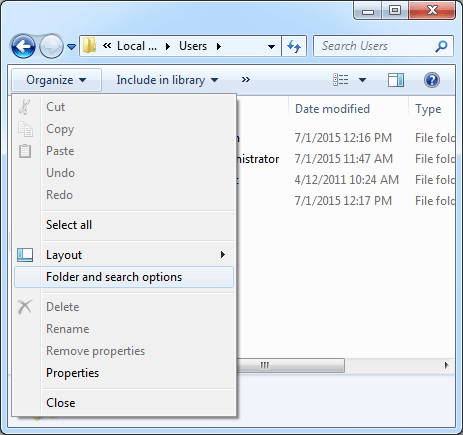-
Search Hidden Folders Vista
All My Files and Folders are Hidden after Rogue Virus attack Lately there has been a constant stream of rogue antivirus software that hides all the files and folders. WinMend Folder Hidden is a free file/folder hiding tool. While ensuring the absolute system safety, this application can quickly hide files and folders on local. Windows hides many files and folders by default, preventing users from deleting or modifying files they shouldn’t touch. But you can make Windows show these hidden.
All My Files and Folders are Hidden after Rogue Virus attack Lately there has been a constant stream of rogue antivirus software that hides all the files and folders. WinMend Folder Hidden is a free file/folder hiding tool. While ensuring the absolute system safety, this application can quickly hide files and folders on local. Windows hides many files and folders by default, preventing users from deleting or modifying files they shouldn’t touch. But you can make Windows show these hidden.


LESSON 4 - FILE MANAGEMENT Objective Create a Folder Rename a Folder Create a folder structure Learn how to select files and folders. Information about how to stop viewing hidden files in Microsoft Windows. My Documents is the commonly recognized name of a special folder in Microsoft Windows (even though starting with Windows Vista, it is called Documents only, and the. Alan Norton shows you how to copy shortcuts to the All Users folders in Windows 7 - it is not the same procedure as in Windows XP.
Methods to Reset System and Hidden Attributes for Files or Folders Caused by Virus. Different viruses cause different types of damage on your computer. Most of the time, the viruses are programmed to disable Windows Task Manager, Regedit, Command Prompt, folder options and etc. These restrictions are meant to prevent a normal computer user from using these built- in Windows diagnostic tools such as MSCONFIG to disable the virus from starting up on your computer. There are some viruses that will cause destruction such as encrypting recently used files so you are forced to buy the decryption key from the virus programmer. Then there’s another type of virus such as BDS. Mirc. Backdoor that will hide your document files by setting the hidden and system attributes to the file.
You can still see the files if you set to show hidden files and folders plus disabling hide operating system files. Another trick is to use Google Chrome, Firefox or Opera to reveal the hidden files.
If the virus is capable of restricting Folder Options, the chances are you think that your files have been wiped out by the virus but in fact they are perfectly safe and have just been hidden in your system. There’s still hope if you think that your files are gone because of a virus. Here’s how to check if the files are still around, and if they are, you can reset the attributes of the files to view them normally in Windows Explorer again.

How to show hidden files in Windows 7. Windows 7 hides certain files so that they are not able to be seen when you exploring the files on your computer. How to Find Hidden Files and Folders in Windows. This wikiHow teaches you how to display and locate hidden files and folders in Windows. Open the Start menu.
How to show hidden files and folders or system files. Go to Control Panel and open Folder Options. Go to the View tab and select “Show hidden files and folders”. Then uncheck “Hide protected operating system files”. Do take note that some viruses that are still active on the computer will revert the changes that you made. So make sure your computer is clean from viruses first by scanning with an antivirus program. Try to look for your missing files on your hard drive.
There is a tool called Random’s System Information Tool that is able to help you find files or folders created or modified in the last 1 to 3 months. If you have managed to locate your files which are hidden but visible because you’ve configured the Folder Options to show them, then you’ll need to unhide the hidden files.
Here are 4 methods to reset the system and hidden attributes. Unhide using the Windows attrib command. This is the old school method of doing it without using any software. Just run command prompt (Start - > Run - > CMD for XP, or for Vista and 7 Start - > type CMD in search box, right click and run as Admin), type the following command: attrib - H - S C: \path\to\your\file.
S /DYou can also use the asterisk character to define multiple extensions. For example: attrib - H - S C: \raymond\*.* /S /DThis would remove the Hidden and System attribute of all files in the raymond folder on the C drive. The /S and /D arguments are optional.
How to configure Windows to show file extensions and hidden files - Win. Zip. In order to avoid confusion regarding your saved files, you may want to configure Windows to show all common file extensions, such as . This will help differentiate between different archives (and other files).
You may also want to configure Windows to show you hidden files and folders. Both involve using the same Control Panel applet. Here are the steps: Windows 1.
Click Start and then click File Explorer. Click the View tab in File Explorer and then click the Options button (or click the drop down menu and click Change folder and search options)Click the View tab at the top of Folder Options. To see file extensions, uncheck Hide extensions for known file types. To see hidden files and folders, select Show hidden files, folders, and drives. Click OKWindows 8: On the Start menu screen start typing.
-
Commentaires
